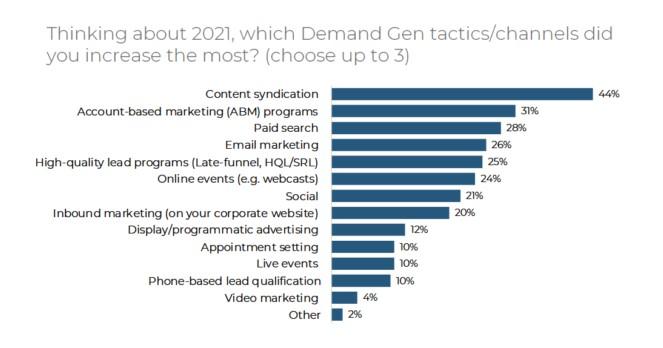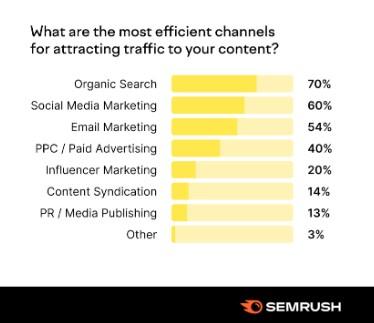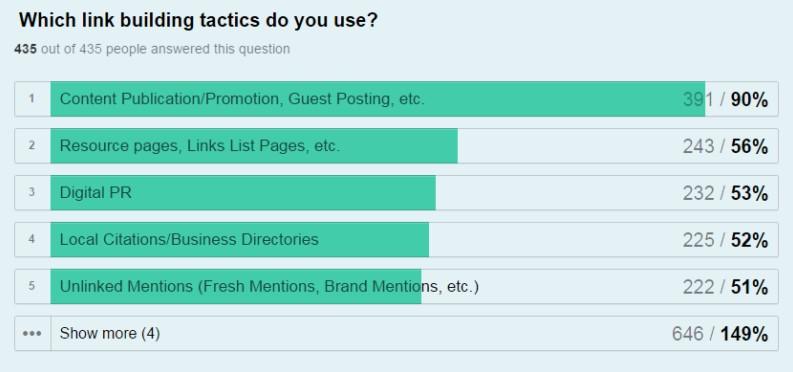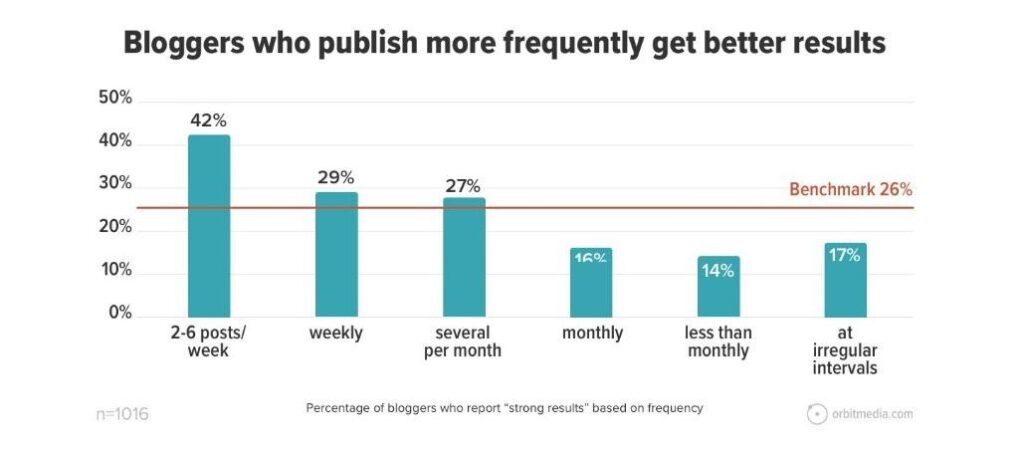What Is Blog Content Syndication? Boost Client Wins With This Tactic
Daniel Trick
Dec 01, 2023
8 min read
Content syndication can help you get more eyes on your content. You can republish your blog content on multiple websites and platforms.
This can help you reach a wider audience. It’s also a good way to build links and boost SEO performance.
But it can hurt your search ranking if not done carefully.
In this guide, we’ll break down what content syndication is and how to do it the right way.
We’ll cover:
- What content syndication is
- The benefits of web content syndication
- The different ways you can syndicate content
- How to do it
- How to SEO-proof your syndicated content
What Is Blog Content Syndication?

Blog content syndication is a strategy that involves republishing content on third-party websites and platforms. This can increase the reach of a piece of content and drive more traffic to your website.
Some content syndication partners will republish a blog post in full. Others will show extracts or edit the piece to make it shorter.
When a third-party website republishes content, it will usually include a note with a link to the original article:

Content syndication benefits the publisher and the source of the original content. The website gets a fresh post to share with its audience, and the content creator can reach a wider audience.
Benefits of Content Syndication
More and more companies are making syndication a key part of their content marketing strategies.
In 2021, 44% of marketers increased their use of content syndication:

Here’s why you should syndicate your content.
Reach a Bigger Audience
The obvious benefit is that more people will read your blog posts. You can get your content republished on high-traffic, high-authority websites.
If your content is valuable, there’s a good chance you can get readers to visit your site.
In a recent Semrush survey, SEOs ranked content syndication as one of the top ways to attract traffic to their content:

Higher Search Rankings
When a website shares your blog post, it will include a link back to the original content on your site.
These will be a mix of nofollow and follow backlinks. But they all contribute to the strength of your link profile and ability to rank high in search results.
Build Credibility
Getting your blog posts featured on authoritative third-party sites and publications is a great way to showcase your expertise.
If your content is published on trustworthy sites, your authority and credibility increase.
Content syndication can help you become an established voice in your niche.
Higher Content ROI
Creating high-quality content takes time and effort.
With content syndication, you can get more value from your blog posts. You can maximize the reach of your top-performing content.
Value-Added SEO Service
Content syndication can be a good add-on service if you offer SEO packages. It can provide an immediate traffic boost while contributing to long-term SEO goals by building links.
Types of Content Syndication
There are different ways to go about syndicating content. Some are completely free, while others are paid.
Here are the main types of content syndication:
Third-Party Platforms
Third-party platforms like Medium, LinkedIn, and Reddit are great options for free content syndication.
You can set up a profile and start sharing your blog posts.
A key benefit of these platforms is that they have large existing audiences. They can help you reach readers who might never have found your blog.
My .@Medium publication has 0% original content – it’s all re-purposed.
And somehow… it now generates over 10,000 views a month.
So yeah. Content syndication is powerful. #contentmarketing pic.twitter.com/4hp5qbDTs1
— Ryan Law (@thinking_slow) June 26, 2018
Medium makes it super-easy to syndicate your content.
You can use the ‘Import a Story’ feature to republish your blog content on the platform in a couple of clicks. It even automatically adds a canonical tag pointing to the original article on your website.
Social Media Platforms
Social media platforms like Facebook, Twitter, and Instagram have huge user bases.
While they are generally more visual-based, you can share your blog posts on these platforms.
In a recent Semrush survey, sharing content on social media was ranked as the most used organic content promotion tactic:

The best way to go about content syndication on social media is to adapt your strategy for each platform.
You can extract snippets from your blog post and create customized social media posts. A tweet thread works well on X (Twitter), while swipeable carousels are a good option for LinkedIn.
Add a link to the full blog post in the comments.
Syndication Networks
Paid content syndication platforms partner with a range of publishers. These networks can share your content on small blogs, major media publications, and industry news sites.
First, you send your content to the network for review. Once it passes their check, they send it to various partnered websites.
Many content syndication networks also provide reports to show you how your content is doing. You can see the number of websites the content has been published on and access the live URLs.
Some networks even show how many people viewed, shared, or interacted with your content.
Guest Post Syndication
Guest posting is one of the best ways to build backlinks.
Instead of posting on your own blog, you publish your original content on a relevant, high-authority third-party website.
You’ll get a link in the author bio and usually get to include a link to your site in the content. This can be super-beneficial for your search ranking.
You can also syndicate your guest posts.
Depending on the rules of the third-party website, you can share your guest post on your blog, Medium, and LinkedIn.

You’ll usually have to wait at least a few weeks after the original post is published – this gives search engines time to add it to their index.
This can be an excellent way to get more value from your guest posts.
You can do the same thing with your press releases. Don’t just submit your press releases to distribution services. Post it on your website.
This can increase the number of backlinks you attract, as your site is the source of the information.
Referral Traffic Sources
Referral traffic sources are websites that can send people to your blog.
What we’re really talking about here is resource pages. Some websites list a bunch of articles on specific topics for people to read.
Getting your blog posts featured in these lists can be a great way to attract traffic and backlinks.
A Search Engine Land survey found that getting links placed on resource pages was the 2nd most popular link building tactic used by SEOs:

For example, a website about healthy living might create a list of articles about different types of exercise and diets.
If you have a blog post about healthy recipes, you could ask the site owner to include a snippet from your post with a link to the full article on your website.
The website gets to share your resource with its readers, and you get more traffic and a quality backlink.
How to Use Content Syndication Strategy in Blogging?
Content syndication can be a really useful tool for your SEO and blogging strategy.
Here’s how to do it:
Identify Target Audiences
The first step is to know who you want to reach.
Think about the demographics and interests of your target audience.
If you have established buyer personas, you’ll have a good breakdown of your audience segments. You can also use your website analytics to get a better understanding of the people who already interact with your content.
Once you know who you want to reach, think about where they go to find information.
Which social media platforms do they use? Which websites do they frequently visit?
This will help you identify the best places to share your content.
Create Unique and Original Content for Syndication
The next step is to write blog posts that people want to read and that other websites want to share.
In some cases, you may be able to syndicate content already published on your blog. You can update your top-performing posts with new information and submit them for paid and free syndication.
Consider the format that will work best for the topic you want to cover. Some types of content are better suited for some platforms and publications than others.
How-to articles and listicles can work well on a broad range of sites. Original research and expert opinion pieces are a better fit for more formal industry publications.
Regularly Publish Original Posts on Your Blog
Content syndication is a great way to increase the reach of your existing content.
But it’s not a substitute for publishing fresh, high-quality content on your own website.
A recent study revealed that higher blogging frequency correlates with better results. Bloggers that publish 2-6 times per week are 50% more likely to report strong results.

Keep creating content for your own site and use syndication to share it with more people.
You can outsource content creation if you’re struggling to keep up your posting frequency.
Focus on Quality Over Quantity of Content
If you want to get your content onto well-known websites, it’s got to be really good.
Focus on quality over quantity.
In a recent Hubspot survey, 83% of marketers agreed that content quality is more important than quantity.

Instead of cranking out multiple shorter posts that skim over a topic, create an in-depth piece that offers more value.
That could include spending more time on research to back up your points and more time on content presentation.
When your syndicated article looks great, people are more likely to engage with it. This could mean more shares, comments, and traffic to your website.
Develop a Network of Third-Party Sites and Platforms for Distribution
The next step is identifying websites and platforms that align with your target audience. You also need to narrow in on websites that accept syndicated content.
Google is the best tool for this task.
Websites that publish syndicated content use similar key terms when linking to original articles.
Combine a phrase like “originally published on” with a relevant keyword to discover publications in your niche that republish content.
How do you find content syndication opportunities?
Usually, publications link back to syndicated content using a few phrases:
– originally appeared on
– originally published on
– republished with permissionUse these to find sites that have republished content before. pic.twitter.com/uHYSbVFPdI
— Ahrefs (@ahrefs) April 2, 2020
Focus on sites that have a good reputation and high traffic. These publications have the biggest reach.
Once you’ve created a list of target sites, send a personalized email asking if they would be interested in sharing your posts.
It can take time to build a content syndication network from scratch.
You can use content syndication services to speed up the process and tap into existing networks of relevant websites and publishers.
SEO-Proofing Content Syndication
Content syndication can boost SEO performance and search ranking.
But it can cause duplicate content issues if done incorrectly.
You need to do a few things to protect your search ranking.
The big thing here is canonicalization.
When your content is published on another site, the publisher should include a canonical tag in their version of the content.
This tag should point back to the original article on your own website.

This tells search engines that your version is the original and should be the page included in search results.
Timing is also key.
You should wait at least a few weeks after publishing a piece on your blog before you submit it for syndication. This allows search engines to crawl and index your original content first.
Like guest posting and blogger outreach, choosing high-quality, relevant platforms for syndication is important. Sharing your content on spammy or irrelevant sites can harm your SEO.
Make sure you research your target sites and web content syndication partners.
Increase Your Reach and ROI With Content Syndication
Syndicating your content can be a great way to get more eyes on your posts. It can help you rank higher in search results and position you as a go-to source of information in your niche.
It’s a no-brainer.
If you want to expand your SEO services and deliver better client results, get started with content syndication.
Become a Pro at SEO
Join 65,000 others and learn the secrets to SEO success with our weekly blog posts.
